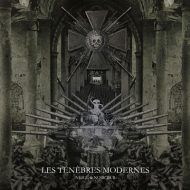 I have followed the black and wintry path of Neige et Noirceur since their 2009 album “Crépuscule Hivernale sans fin sure Les Terrres de Guerre”. and without doubt these Québecois have carved an interesting path of black ambient music. Occasionally it’s been quirky, sometimes ambient drone has been the modus operandi, and much of the time the black metal has been harsh and violent. World War I is at the centre of the latest bout of hostilities.
I have followed the black and wintry path of Neige et Noirceur since their 2009 album “Crépuscule Hivernale sans fin sure Les Terrres de Guerre”. and without doubt these Québecois have carved an interesting path of black ambient music. Occasionally it’s been quirky, sometimes ambient drone has been the modus operandi, and much of the time the black metal has been harsh and violent. World War I is at the centre of the latest bout of hostilities.
“Ténèbres Modernes” immediately conjures up black and grey scenes, and rasping, rusty harshness characterises “Battlespirit” and “Walpurgis 1917”, the latter being short but full of dark majesty in the best spirit of old school black metal. Distant gunfire leads us into the sombre march of “Las Saison des Morts”. The tension rises towards the end but my frustration mounted as what I was hearing was a series of cameos, and nothing to embroil me in all the horror. “La Mécanique de Lucifer” breaks the mould, crustily trudging its way through black metal gloom, breaking off for an all-too-brief madcap violin moment and then bursting into despair and a thunderous conclusion. Mayhem ensues – this for me was more interesting and could have been developed more than the standard black metal obscurity which the ensuing “Ciel d’Acier” (Steel Sky) brings back to the table. “Ciel d’Acier” is pungent and darkest clouds gather but I did not experience anything exceptional. The industrial sound waves, which mix with the gunfire at the end, are more interesting. This development continues with the ambient “Felgrau”, whose deep sound waves finally succeed in capturing on a sustained level the rumbling thunder and tragedy of war. The awe-inspiring mood is continued with the belligerent anthem “Des Spectres” but it fades away and is just too short to make an impact. An angelic choir sings over gunfire and simultaneous German and French diction. Sirens, more gunfire, sharp violins and more diction create an increasingly confusing and chaotic scene. “Adieux” has an aura and unique atmosphere, which had largely been hidden away.
Although the theme is World War I, until the last part I didn’t get any special sense of the events associated with it beyond the occasional gunfire. The black metal is bleak and nasty, but I found “Ténèbres Modernes” patchy and for that reason it was difficult to appreciate the totality of the atmosphere, which came and went over its course.
(6.5/10 Andrew Doherty)

Leave a Reply